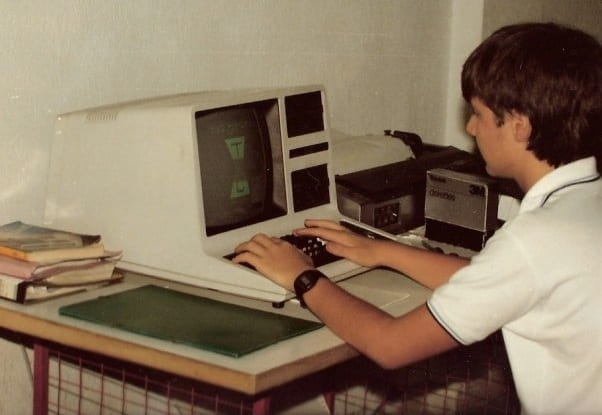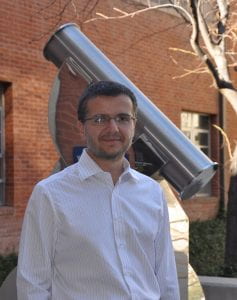 Dimitrios Psaltis was born in Serres, a town in northern Greece, on Monday June 1, 1970, a day he used to believe was the first day of the week, the first day of the month, and the first day of summer. He spent most of the years in junior-high and in high school working as a part-time programmer in a computer company. During the last year of high school he realized that he did not want to spend one more minute of his life debugging computer codes or studying Ancient Greek and decided to study Physics at the University of Thessaloniki.
Dimitrios Psaltis was born in Serres, a town in northern Greece, on Monday June 1, 1970, a day he used to believe was the first day of the week, the first day of the month, and the first day of summer. He spent most of the years in junior-high and in high school working as a part-time programmer in a computer company. During the last year of high school he realized that he did not want to spend one more minute of his life debugging computer codes or studying Ancient Greek and decided to study Physics at the University of Thessaloniki.
Within two months after graduating from high school he was hired by a computer company to develop software for the teaching of Ancient Greek in private and public schools! In the fall of 1988 he started attending classes at the Physics Department of the Aristotle University of Thessaloniki and soon afterwards he started looking for a research project. He never considered working on nuclear or particle physics being afraid that his work might be used for the development of nuclear weapons. An unsuccessful, one-semester project in solid-state physics was enough to drive him as far away as possible from this field too. Research in Astronomy was the only obvious way forward (fortunately for his solid-state physics professors but unfortunately for his astronomy ones) and he spent the last 3 years in college working on various problems in astronomy at the Observatory of the University of Thessaloniki, as well as at the Astronomical Institute of the University of Amsterdam (funded by the Erasmus program for exchange students) and at the Max-Planck Institute fuer Radioastronomie in Bonn.
He graduated in July 1992 and started his graduate studies in the Astronomy and Physics Departments of the University of Illinois at Urbana-Champaign, working on his doctoral thesis, mostly spending his time debugging his radiative transport code and working on a project that could (but he really hopes it won’t) be used for developing nuclear weapons. An administrative error forced him to turn down a Marie Curie postdoctoral fellowship of the European Union to be taken at the University of Amsterdam (his most favorite place in the world until then), and stay in the U.S.
In 1997 he moved to the Harvard-Smithsonian Center for Astrophysics, as a Smithsonian Postdoctoral Fellow. He loved the east coast so much that, even though he had already accepted a faculty position at the University of Arizona, he decided to stay for an extra year in Cambridge, MA, as a postdoctoral researcher at MIT, and for two years as a long-term member at the Institute of Advanced Study, in Princeton, NJ. In January 2003, he started his faculty position at the University of Arizona, where he stayed until August 2022.
 His group at the University of Arizona pioneered the development of tests of Einstein’s theory of General Relativity using observations of black holes and neutron stars in the electromagnetic spectrum. They pushed the limits of high-performance computing, performing some of the very first simulations on Graphic Process Units (GPUs) and employing vast amounts of computing resources.
His group at the University of Arizona pioneered the development of tests of Einstein’s theory of General Relativity using observations of black holes and neutron stars in the electromagnetic spectrum. They pushed the limits of high-performance computing, performing some of the very first simulations on Graphic Process Units (GPUs) and employing vast amounts of computing resources.
In 2012, he co-organized in Tucson, AZ, the inaugural meeting of the Event Horizon Telescope collaboration, where colleagues from many institutions around the world convened to launch the project that took the first pictures of black holes. As the inaugural Project Scientist of the collaboration and the PI of the international Black-Hole PIRE Project, he guided the analyses that led to the first full-array observations of the Event Horizon Telescopes in 2017 and 2018 and the generation of the first black hole picture announced in April 2019. He also led the first tests of Einstein’s theories with black hole images.
In August 2022, he moved to the School of Physics at Georgia Tech, where he now spends most of his time teaching graduate and undergraduate students, doing research, giving public talks, traveling to international collaborative meetings and conferences, enjoying life with his family, hiking, cycling, diving, and flying.
